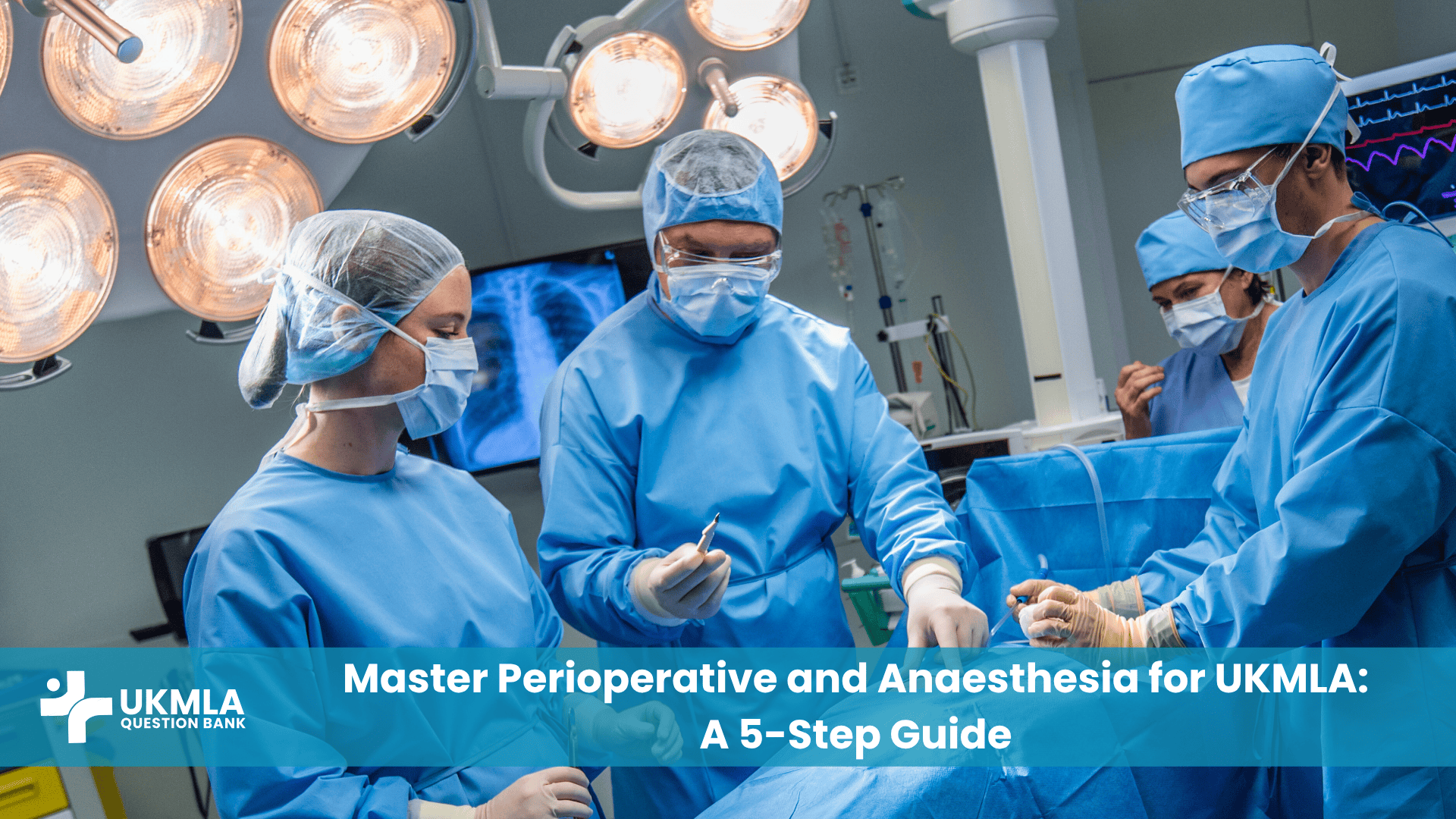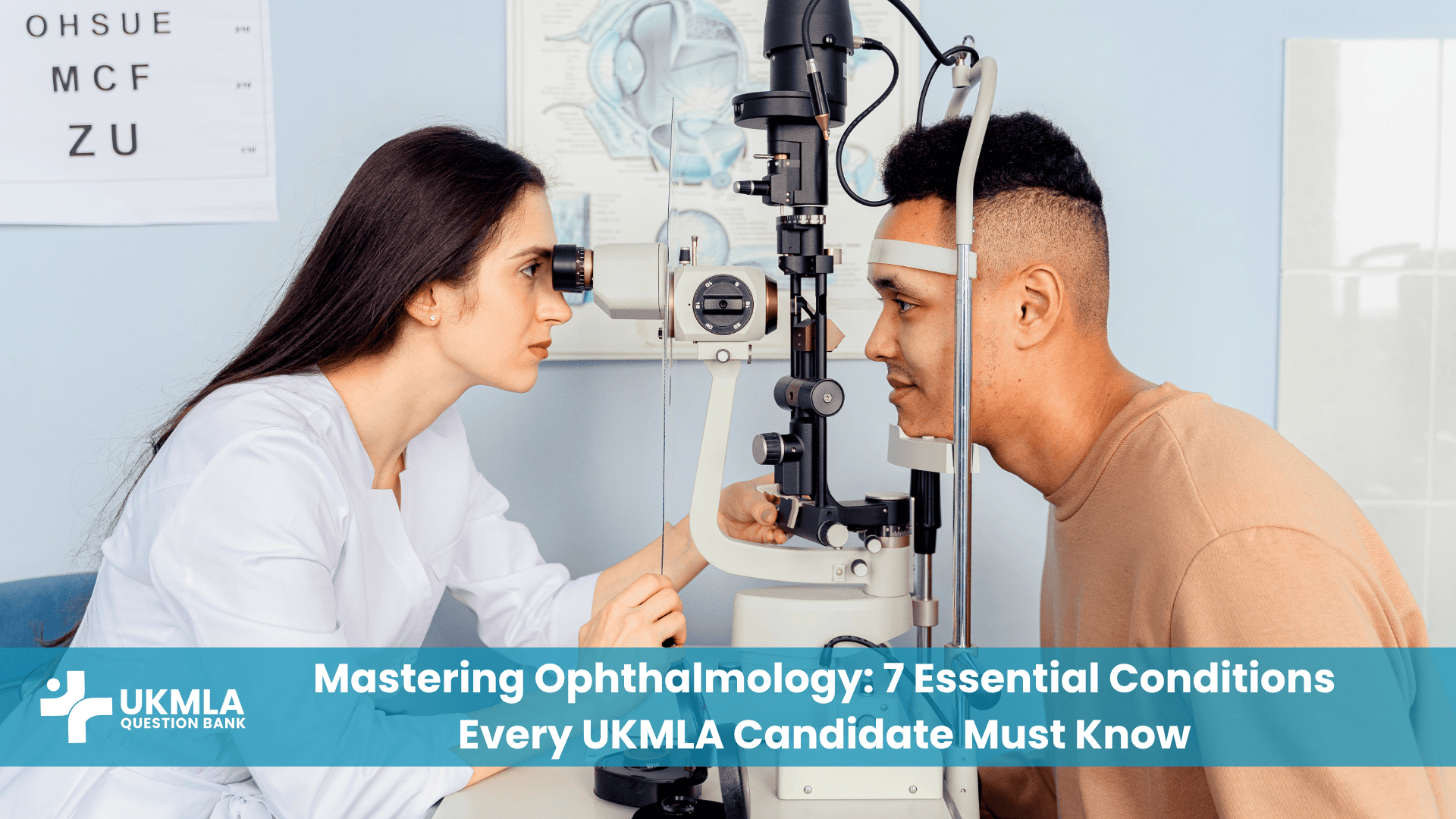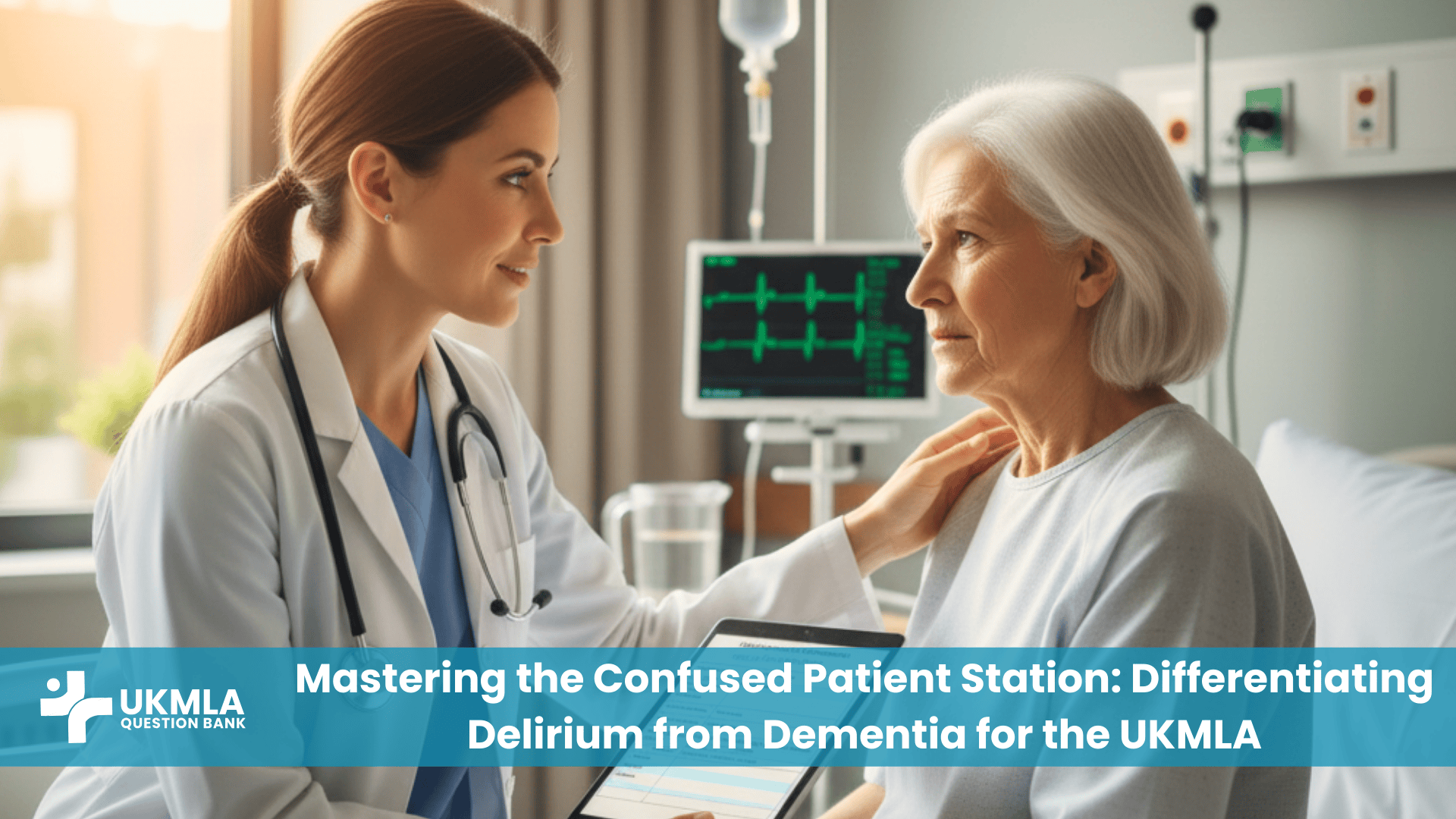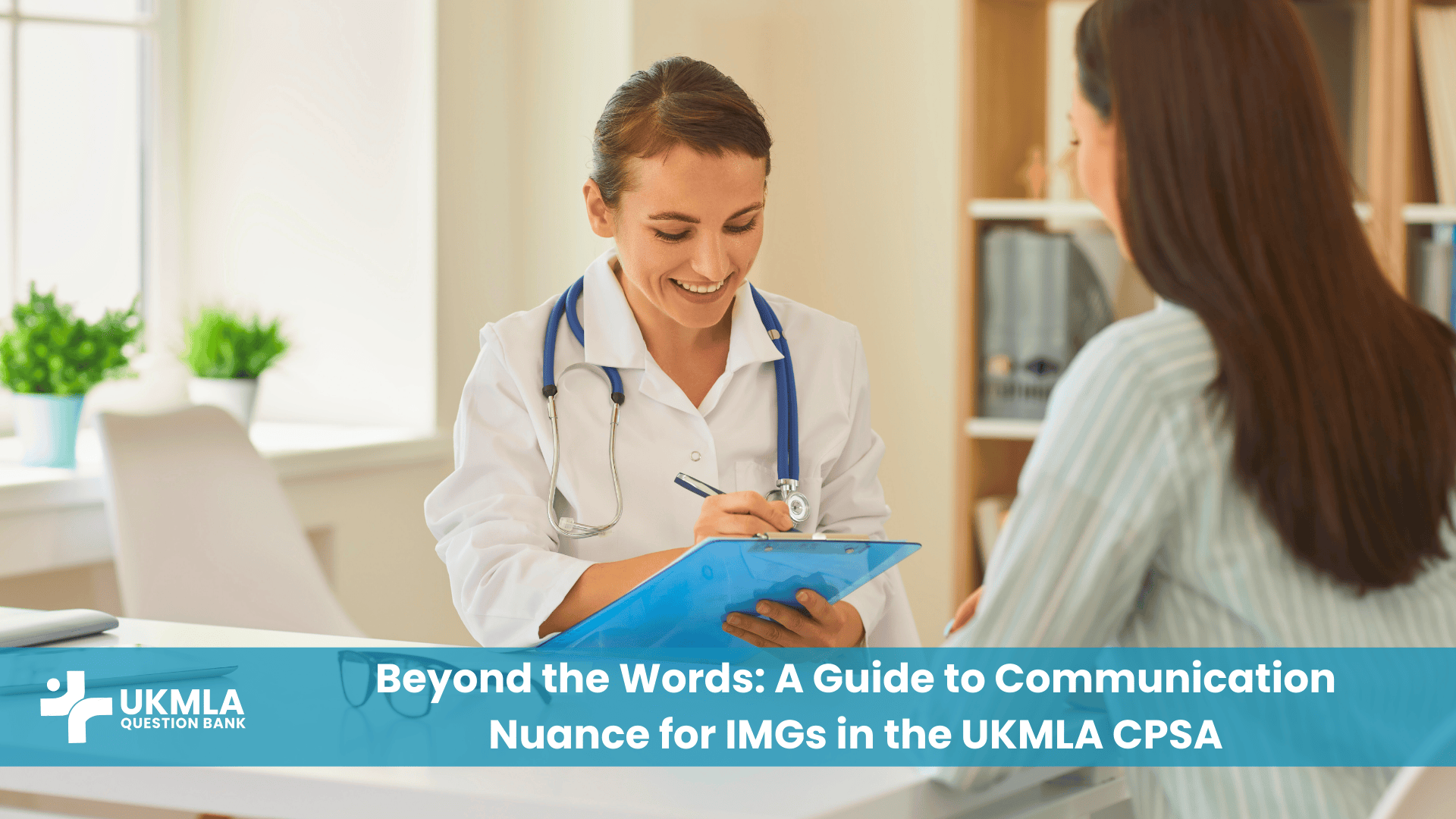Introduction
Mastering the essentials of perioperative and anaesthesia for UKMLA is a crucial component of your preparation for the Applied Knowledge Test (AKT). Regardless of which specialty you ultimately pursue, as a Foundation Year 1 (FY1) doctor, you will be deeply involved in the care of patients on a surgical journey. Your ability to assess a patient’s fitness for surgery, understand anaesthetic risks, and manage common post-operative complications is fundamental to safe and effective practice.
The UKMLA does not expect you to be an anaesthetist, but it absolutely expects you to be a safe junior doctor who understands the principles of the entire perioperative pathway. This guide is designed to provide a clear and simple framework. We will walk you through a 5-step guide covering the key concepts from pre-operative assessment to enhanced recovery, giving you the confidence to excel in these questions.
Table of Contents
ToggleA 5-Step Guide to Perioperative and Anaesthesia for UKMLA
The perioperative journey is a process. By breaking it down into these five logical steps, you can structure your thinking for any question the UKMLA AKT throws at you.
1: Pre-operative Assessment & Optimisation
This is the foundation upon which safe surgery is built. The goal is to identify and mitigate patient-specific risks before they ever enter the operating theatre. A thorough pre-operative assessment is key.
-
The Focused History: Your history-taking must be targeted. Beyond the surgical problem, you need to explore comorbidities that increase surgical risk, such as ischaemic heart disease, COPD, diabetes, and obstructive sleep apnoea. Ask specifically about previous issues with anaesthesia in the patient or their family (e.g., malignant hyperthermia). A crucial part of the history is assessing a patient’s functional capacity, often measured in Metabolic Equivalents (METs). Being able to climb two flights of stairs (4 METs) is a good indicator of being able to tolerate the physiological stress of major surgery. For more tips on this, refer to our guide on UKMLA history taking.
-
The ASA Grade: This is a high-yield classification system you must know. The American Society of Anesthesiologists (ASA) physical status classification is used to grade a patient’s overall health and surgical risk.
Table 1: The ASA Physical Status Classification System
| Grade | Description | Example |
|---|---|---|
| ASA 1 | A normal healthy patient. | A fit, non-smoking young person with no medical problems. |
| ASA 2 | A patient with mild systemic disease. | A patient with well-controlled hypertension or diabetes. |
| ASA 3 | A patient with severe systemic disease. | A patient with poorly controlled diabetes or stable angina. |
| ASA 4 | A patient with severe systemic disease that is a constant threat to life. | A patient who has had a recent MI, sepsis, or ongoing cardiac ischaemia. |
| ASA 5 | A moribund patient who is not expected to survive without the operation. | A patient with a ruptured aortic aneurysm. |
| ASA 6 | A declared brain-dead patient whose organs are being removed for donor purposes. | N/A for most scenarios. |
2: Anaesthetic Risk & Consent
This step involves communicating the findings of the pre-op assessment to the patient and taking informed consent.
Types of Anaesthesia: You should have a basic understanding of the options:
General Anaesthesia (GA): A reversible, drug-induced loss of consciousness.
Regional Anaesthesia: Numbing a large area of the body (e.g., a spinal or epidural anaesthetic).
Local Anaesthesia: Numbing a small, specific area of tissue.
Informed Consent: The process of consent for anaesthesia is as important as consent for surgery. The anaesthetist will discuss common risks (like post-operative nausea and vomiting, sore throat, headache) and rare but serious risks (like anaphylaxis, nerve damage, awareness during surgery, or death). This conversation must be tailored to the individual patient and their specific risk factors. For more on this, our guide to Medical Ethics and Law for UKMLA is essential reading.
3: The ‘Safe Surgery’ Principles (Intraoperative)
While you won’t be in theatre for the AKT, you are expected to know the key safety processes that happen there.
The WHO Surgical Safety Checklist: This is a globally adopted tool designed to reduce errors and improve teamwork in the operating theatre. You must know its three key stages:
Sign In: Before induction of anaesthesia. The team confirms patient identity, site of surgery, consent, and checks the anaesthetic machine and patient allergies.
Time Out: Before the first incision. The entire team pauses to confirm they have the right patient, for the right operation, on the right site. Critical steps are verbally confirmed.
Sign Out: Before the patient leaves the operating room. The team confirms the name of the procedure performed, that instrument and swab counts are correct, and discusses key plans for post-operative recovery.
From the World Health Organization (WHO): “The Checklist is a tool to help ensure that teams consistently follow the few critical steps that have been scientifically shown to improve the safety of surgical care. It is not a substitute for clinical judgment but a support for it.”
4: Post-operative Care & Complications
The care you provide as an FY1 doctor on the ward is critical for identifying and managing post-operative complications. A systematic approach is vital.
The ABCDE Approach in Recovery: The immediate post-operative period is high-risk. Always use the ABCDE approach to assess a patient who is unwell. Airway obstruction (due to residual anaesthetic), Breathing (e.g., atelectasis), and Circulation (e.g., haemorrhage, hypotension) are key immediate concerns.
Common Complications by Timeframe (The “Ws”): A useful way to remember common complications is by when they typically occur:
Wind (Day 1-2): Chest infection (pneumonia) and atelectasis are common, especially after major abdominal or thoracic surgery.
Water (Day 3-5): Urinary tract infections (UTIs) are common, especially if the patient was catheterised.
Wound (Day 5-7): Wound infections typically present around this time with redness, swelling, pain, and discharge.
Walking (Day 5+): Deep Vein Thrombosis (DVT) and subsequent Pulmonary Embolism (PE) are a major risk due to immobility.
Wonder Drugs (Any time): Always consider if a fever or rash could be due to a drug reaction.
5: Enhanced Recovery After Surgery (ERAS)
ERAS, or “fast-track surgery,” is a modern, evidence-based approach designed to reduce the physiological stress of surgery and improve recovery. You should understand its core principles.
Pre-operative: This includes patient education, avoiding prolonged fasting, and “carbohydrate loading” with special drinks before surgery.
Intra-operative: This involves using regional anaesthesia where possible to reduce opioid use, maintaining normal body temperature, and managing fluids carefully.
Post-operative: The focus is on early nutrition, early mobilisation (getting the patient out of bed on day 1), and using non-opioid pain relief to avoid the side effects of morphine.
The goal of ERAS is to get patients back to their normal function faster, reduce complications, and shorten hospital stays. You can learn more from patient-facing resources provided by the Royal College of Anaesthetists.
Applying Perioperative Principles to UKMLA Questions
SBA (Single Best Answer) questions in this area will test your ability to apply these principles.
Deconstructing the Pre-op Assessment SBA: When given a pre-operative scenario, your first step is to calculate the ASA grade. This will immediately help you stratify the patient’s risk. Look for optimisable factors—can their asthma be improved? Do they need to stop a specific medication?
Identifying the Most Likely Post-operative Complication: Use the “timeframe” rule. If a patient develops a fever on day 1 post-op, a chest infection is a very likely cause. If they develop a fever on day 5, a wound infection or DVT becomes more likely. This is a very common style of question. For more tips, check our guide on how to tackle SBAs effectively.
Frequently Asked Questions (FAQ): Perioperative Care & Anaesthesia
The Mallampati score is part of an airway assessment used to predict the ease of intubation. It involves assessing the visibility of the faucial pillars, uvula, and soft palate. A higher score (e.g., Class IV, where only the hard palate is visible) suggests a potentially difficult intubation.
NCEPOD (National Confidential Enquiry into Patient Outcome and Death) provides a classification for surgical urgency. You should be familiar with the terms: Immediate (life-saving, within minutes), Urgent (within hours), Expedited (within days), and Elective.
No. You are not expected to know the doses of induction agents like propofol. However, you are expected to know the doses of common analgesics, anticoagulants, and emergency drugs that you would prescribe as an FY1 doctor.
Traditionally, patients were “nil by mouth” from midnight. Modern ERAS guidelines are different. A common policy is 6 hours for food and 2 hours for clear fluids before anaesthesia.
This requires careful management. Warfarin is usually stopped 5 days before surgery, and the patient may need to be “bridged” with low-molecular-weight heparin (LMWH) injections if they are at high risk of thrombosis. Their INR must be checked before the operation.
It is a rare but life-threatening inherited condition where exposure to certain anaesthetic agents causes a hypermetabolic state with muscle rigidity, high fever, and tachycardia. A family history of problems with anaesthesia is a major red flag.
This is very common. Risk factors include female sex, non-smokers, and a history of motion sickness. Management involves prophylactic antiemetics for high-risk patients and using a combination of drugs with different mechanisms (e.g., ondansetron and cyclizine) for treatment.
As an FY1, you will be responsible for prescribing maintenance fluids. You need to calculate the patient’s daily requirement of water and electrolytes (sodium, potassium) and account for any ongoing losses.
Post-operative confusion is common, especially in the elderly. The differential is broad. Always consider and rule out reversible causes first: hypoxia, infection, dehydration/electrolyte imbalance, pain, and urinary retention.
While this guide provides the framework, the best way to learn is by applying it. Use a high-quality UKMLA question bank to work through pre-operative and post-operative scenarios until the systematic approach becomes second nature.
Conclusion & Call to Action (CTA)
Mastering the essentials of perioperative and anaesthesia for UKMLA is about understanding a single, continuous journey that is anchored by the principle of patient safety. By using the 5-step framework—from pre-operative assessment to enhanced recovery—you can logically approach any question related to a surgical patient.
Remember to think systematically. Use tools like the ASA grade and the WHO checklist, and always apply an ABCDE approach to an unwell post-operative patient. This structured thinking is exactly what the UKMLA assesses and what will make you a safe and competent FY1 doctor.
Ready to test your ability to manage surgical patients safely? Dive into the comprehensive UKMLA Question Bank and master the perioperative scenarios you will face in your AKT.




